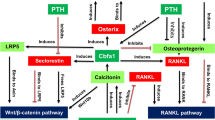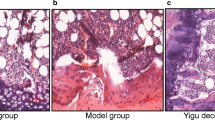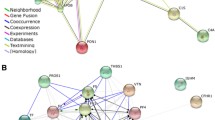Abstract
Postmenopausal osteoporosis is a public health problem leading to an increased risk of fractures, negatively impacting women’s health. The absence of sensitive and specific biomarkers for early detection of osteoporosis represents a substantial challenge for improving patient management. Herein, we aimed to identify potential candidate proteins associated with low bone mineral density (BMD) in postmenopausal women from the Mexican population. Serum samples from postmenopausal women (40 with normal BMD, 40 with osteopenia (OS), and 20 with osteoporosis (OP)) were analyzed by label-free LC–MS/MS quantitative proteomics. Proteome profiling revealed significant differences between the OS and OP groups compared to individuals with normal BMD. A quantitative comparison of proteins between groups indicated 454 differentially expressed proteins (DEPs). Compared to normal BMD, 14 and 214 DEPs were found in OS and OP groups, respectively, while 226 DEPs were identified between OS and OP groups. The protein–protein interaction and enrichment analysis of DEPs were closely linked to the bone mineral content, skeletal morphology, and immune response activation. Based on their role in bone metabolism, a panel of 12 candidate biomarkers was selected, of which 1 DEP (RYR1) was found upregulated in the OS and OP groups, 8 DEPs (APOA1, SHBG, FETB, MASP1, PTK2B, KNG1, GSN, and B2M) were upregulated in OP and 3 DEPs (APOA2, RYR3, and HBD) were downregulated in OS or OP. The proteomic analysis described here may help discover new and potentially non-invasive biomarkers for the early diagnosis of osteoporosis in postmenopausal women.






Similar content being viewed by others
Data Availability
The authors confirm that the data supporting the findings of this study are available within the article and its supplementary materials.
References
Reginster JY, Burlet N. Osteoporosis: a still increasing prevalence. Bone. 2006;38(2 Suppl 1):4–9. https://doi.org/10.1016/J.BONE.2005.11.024.
Gossiel F, Altaher H, Reid DM, et al. Bone turnover markers after the menopause: T-score approach. Bone. 2018;111:44–8. https://doi.org/10.1016/J.BONE.2018.03.016.
Johnell O, Kanis JA. An estimate of the worldwide prevalence and disability associated with osteoporotic fractures. Osteoporos Int. 2006;17(12):1726–33. https://doi.org/10.1007/S00198-006-0172-4.
Becker DJ, Kilgore ML, Morrisey MA. The societal burden of osteoporosis. Curr Rheumatol Rep. 2010;12(3):186–91. https://doi.org/10.1007/S11926-010-0097-Y.
Carlos F, Clark P, Galindo-Suárez RM, Chico-Barba LG. Health care costs of osteopenia, osteoporosis, and fragility fractures in Mexico. Arch Osteoporos. 2013;8(1):125. https://doi.org/10.1007/S11657-013-0125-4.
Aziziyeh R, Amin M, Habib M, et al. A scorecard for osteoporosis in four Latin American countries: Brazil, Mexico, Colombia, and Argentina. Arch Osteoporos. 2019;14(1):69. https://doi.org/10.1007/S11657-019-0622-1.
Albergaria BH, Chalem M, Clark P, Messina OD, Pereira RMR, Vidal LF. Consensus statement: osteoporosis prevention and treatment in Latin America—current structure and future directions. Arch Osteoporos. 2018;13(1):90. https://doi.org/10.1007/S11657-018-0505-X.
Choksi P, Jepsen KJ, Clines GA. The challenges of diagnosing osteoporosis and the limitations of currently available tools. Clin Diabetes Endocrinol. 2018;4(1):12. https://doi.org/10.1186/S40842-018-0062-7.
Zhang AH, Sun H, Yan GL, Han Y, Wang XJ. Serum proteomics in biomedical research: a systematic review. Appl Biochem Biotechnol. 2013;170(4):774–86. https://doi.org/10.1007/S12010-013-0238-7.
Migliorini F, Maffulli N, Spiezia F, Tingart M, Maria PG, Riccardo G. Biomarkers as therapy monitoring for postmenopausal osteoporosis: a systematic review. J Orthop Surg Res. 2021;16(1):318. https://doi.org/10.1186/S13018-021-02474-7.
Szulc P, Delmas PD. Biochemical markers of bone turnover: potential use in the investigation and management of postmenopausal osteoporosis. Osteoporos Int. 2008;19(12):1683–704. https://doi.org/10.1007/S00198-008-0660-9.
Deutsch EW, Omenn GS, Sun Z, et al. Advances and utility of the human plasma proteome. J Proteome Res. 2021;20(12):5241–63. https://doi.org/10.1021/ACS.JPROTEOME.1C00657.
Greco V, Piras C, Pieroni L, Urbani A. Direct assessment of plasma/serum sample quality for proteomics biomarker investigation. Methods Mol Biol. 2017;1619:3–21. https://doi.org/10.1007/978-1-4939-7057-5_1.
Deng FY, Liu YZ, Li LM, et al. Proteomic analysis of circulating monocytes in Chinese premenopausal females with extremely discordant bone mineral density. Proteomics. 2008;8(20):4259–72. https://doi.org/10.1002/PMIC.200700480.
Lv M, Cui C, Chen P, Li Z. Identification of osteoporosis markers through bioinformatic functional analysis of serum proteome. Medicine. 2020;99(39):e22172. https://doi.org/10.1097/MD.0000000000022172.
Huang D, Wang Y, Lv J, et al. Proteomic profiling analysis of postmenopausal osteoporosis and osteopenia identifies potential proteins associated with low bone mineral density. PeerJ. 2020;8:e9009. https://doi.org/10.7717/PEERJ.9009/SUPP-8.
Zhang Ll, Li Cw, Liu K, et al. Discovery and identification of serum succinyl-proteome for postmenopausal women with osteoporosis and osteopenia. Orthop Surg. 2019;11(5):784–93. https://doi.org/10.1111/OS.12519.
Hlaing TT, Compston JE. Biochemical markers of bone turnover - uses and limitations. Ann Clin Biochem. 2014;51(Pt 2):189–202. https://doi.org/10.1177/0004563213515190.
Martínez-Aguilar MM, Aparicio-Bautista DI, Ramírez-Salazar EG, et al. Serum proteomic analysis reveals vitamin D-binding protein (VDBP) as a potential biomarker for low bone mineral density in Mexican postmenopausal women. Nutrients. 2019;11(12):2853. https://doi.org/10.3390/NU11122853.
Denova-Gutiérrez E, Flores YN, Gallegos-Carrillo K, et al. Health workers cohort study: methods and study design. Salud Publica Mex. 2016;58(6):708–16. https://doi.org/10.21149/SPM.V58I6.8299.
Kanis JA, Glüer CC. An update on the diagnosis and assessment of osteoporosis with densitometry. Committee of Scientific Advisors, International Osteoporosis Foundation. Osteoporos Int. 2000;11(3):192–202. https://doi.org/10.1007/S001980050281.
Kanis JA, Kanis JA. Assessment of fracture risk and its application to screening for postmenopausal osteoporosis: synopsis of a WHO report. WHO Study Group. Osteoporos Int. 1994;4(6):368–81. https://doi.org/10.1007/BF01622200.
Ortega-Lozano AJ, Jiménez-Uribe AP, Aranda-Rivera AK, et al. Expression profiles of kidney mitochondrial proteome during the progression of the unilateral ureteral obstruction: focus on energy metabolism adaptions. Metabolites. 2022;12(10):936. https://doi.org/10.3390/METABO12100936.
Rios-Castro E, Souza GHMF, Delgadillo-Alvarez DM, et al. Quantitative proteomic analysis of MARC-145 cells infected with a Mexican porcine reproductive and respiratory syndrome virus strain using a label-free based DIA approach. J Am Soc Mass Spectrom. 2020;31(6):1302–12. https://doi.org/10.1021/JASMS.0C00134.
Li GZ, Vissers JPC, Silva JC, Golick D, Gorenstein MV, Geromanos SJ. Database searching and accounting of multiplexed precursor and product ion spectra from the data independent analysis of simple and complex peptide mixtures. Proteomics. 2009;9(6):1696–719. https://doi.org/10.1002/PMIC.200800564.
Käll L, Storey JD, MacCoss MJ, Noble WS. Assigning significance to peptides identified by tandem mass spectrometry using decoy databases. J Proteome Res. 2008;7(1):29–34. https://doi.org/10.1021/PR700600N.
Yu G, Wang LG, Han Y, He QY. clusterProfiler: an R package for comparing biological themes among gene clusters. OMICS. 2012;16(5):284–7. https://doi.org/10.1089/OMI.2011.0118.
Al-Ansari MM, Aleidi SM, Masood A, et al. Proteomics profiling of osteoporosis and osteopenia patients and associated network analysis. Int J Mol Sci. 2022;23(17):10200. https://doi.org/10.3390/IJMS231710200.
Huo C, Li Y, Qiao Z, et al. Comparative proteomics analysis of microvesicles in human serum for the evaluation of osteoporosis. Electrophoresis. 2019;40(14):1839–47. https://doi.org/10.1002/ELPS.201900130.
Nielson CM, Wiedrick J, Shen J, et al. Identification of hip BMD loss and fracture risk markers through population-based serum proteomics. J Bone Miner Res. 2017;32(7):1559–67. https://doi.org/10.1002/JBMR.3125.
Chen M, Li Y, Lv H, Yin P, Zhang L, Tang P. Quantitative proteomics and reverse engineer analysis identified plasma exosome derived protein markers related to osteoporosis. J Proteomics. 2020;228:103940. https://doi.org/10.1016/J.JPROT.2020.103940.
Cawthon PM, Ewing SK, McCulloch CE, et al. Loss of hip BMD in older men: the osteoporotic fractures in men (MrOS) study. J Bone Miner Res. 2009;24(10):1728. https://doi.org/10.1359/JBMR.090419.
Adebanjo OA, Biswas G, Moonga BS, et al. Novel biochemical and functional insights into nuclear Ca(2+) transport through IP(3)Rs and RyRs in osteoblasts. Am J Physiol Renal Physiol. 2000;278(5):F784-91. https://doi.org/10.1152/AJPRENAL.2000.278.5.F784.
Wei H, Bi Y, Wang Y, et al. Serum bone remodeling parameters and transcriptome profiling reveal abnormal bone metabolism associated with keel bone fractures in laying hens. Poult Sci. 2023;102(4):102438. https://doi.org/10.1016/J.PSJ.2022.102438.
Robinson LJ, Blair HC, Barnett JB, Zaidi M, Huang CLH. Regulation of bone turnover by calcium-regulated calcium channels. Ann N Y Acad Sci. 2010;1192:351–7. https://doi.org/10.1111/J.1749-6632.2009.05219.X.
Tao X, Liu L, Yang X, et al. Clinical characteristics and pathogenic gene identification in Chinese patients with Paget’s disease of bone. Front Endocrinol (Lausanne). 2022;13:850462. https://doi.org/10.3389/FENDO.2022.850462.
Tariq E, Mirza L. Early osteoporosis in RYR1-related central core disease. J Endocr Soc. 2021;5(Suppl 1):A191. https://doi.org/10.1210/JENDSO/BVAB048.387.
Chen ZH, Wu JJ, Guo DY, et al. Physiological functions of podosomes: from structure and function to therapy implications in osteoclast biology of bone resorption. Ageing Res Rev. 2023;85:101842. https://doi.org/10.1016/J.ARR.2023.101842.
Chellaiah M, Kizer N, Silva M, Alvarez U, Kwiatkowski D, Hruska KA. Gelsolin deficiency blocks podosome assembly and produces increased bone mass and strength. J Cell Biol. 2000;148(4):665–78. https://doi.org/10.1083/JCB.148.4.665.
Wang WY, Ge B, Shi J, et al. Plasma gelsolin is associated with hip BMD in Chinese postmenopausal women. PLoS One. 2018;13(5):e0197732. https://doi.org/10.1371/JOURNAL.PONE.0197732.
Silacci P, Mazzolai L, Gauci C, Stergiopulos N, Yin HL, Hayoz D. Gelsolin superfamily proteins: key regulators of cellular functions. Cell Mol Life Sci. 2004;61(19–20):2614–23. https://doi.org/10.1007/S00018-004-4225-6.
Saltel F, Chabadel A, Bonnelye E, Jurdic P. Actin cytoskeletal organisation in osteoclasts: a model to decipher transmigration and matrix degradation. Eur J Cell Biol. 2008;87(8–9):459–68. https://doi.org/10.1016/J.EJCB.2008.01.001.
Toroian D, Price PA. The essential role of fetuin in the serum-induced calcification of collagen. Calcif Tissue Int. 2008;82(2):116–26. https://doi.org/10.1007/S00223-007-9085-2.
Özkan E, Özkan H, Bilgiç S, et al. Serum fetuin-A levels in postmenopausal women with osteoporosis. Turk J Med Sci. 2014;44(6):985–8. https://doi.org/10.3906/SAG-1308-28.
Schäfer C, Heiss A, Schwarz A, et al. The serum protein alpha 2-Heremans-Schmid glycoprotein/fetuin-A is a systemically acting inhibitor of ectopic calcification. J Clin Invest. 2003;112(3):357–66. https://doi.org/10.1172/JCI17202.
Kan C, Yang J, Fan H, et al. Fetuin-A is an immunomodulator and a potential therapeutic option in BMP4-dependent heterotopic ossification and associated bone mass loss. Bone Res. 2022;10(1):62. https://doi.org/10.1038/S41413-022-00232-X.
Xu ZH, He J, Zhang X, et al. Serum level of fetuin B is associated with osteoporosis: a 4-year prospective study in China. Clin Invest Med. 2018;41(1):E25–30. https://doi.org/10.25011/CIM.V41I1.29460.
Li L, Spranger L, Stobäus N, et al. Fetuin-B, a potential link of liver-adipose tissue cross talk during diet-induced weight loss-weight maintenance. Nutr Diabetes. 2021;11(1):31. https://doi.org/10.1038/S41387-021-00174-Z.
Jahnen-Dechent W, Heiss A, Schäfer C, Ketteler M. Fetuin-A regulation of calcified matrix metabolism. Circ Res. 2011;108(12):1494–509. https://doi.org/10.1161/CIRCRESAHA.110.234260.
Pliatsika P, Antoniou A, Alexandrou A, et al. Serum lipid levels and bone mineral density in Greek postmenopausal women. Gynecol Endocrinol. 2012;28(8):655–60. https://doi.org/10.3109/09513590.2011.650766.
Sun X, Wu X. Association of apolipoprotein A1 with osteoporosis: a cross-sectional study. BMC Musculoskelet Disord. 2023;24(1):157. https://doi.org/10.1186/S12891-023-06264-6.
Blair HC, Kalyvioti E, Papachristou NI, et al. Apolipoprotein A-1 regulates osteoblast and lipoblast precursor cells in mice. Lab Invest. 2016;96(7):763–72. https://doi.org/10.1038/LABINVEST.2016.51.
Valles V, Aguilar-Salinas CA, Gómez-Pérez FJ, et al. Apolipoprotein B and A-I distribution in Mexican urban adults: results of a nationwide survey. Metabolism. 2002;51(5):560–8. https://doi.org/10.1053/meta.2002.31977.
Aceves-Ramírez M, Valle Y, Casillas-Muñoz F, et al. Analysis of the APOB gene and apolipoprotein B serum levels in a Mexican population with acute coronary syndrome: association with the single nucleotide variants rs1469513, rs673548, rs676210, and rs1042034. Genet Res (Camb). 2022;4901090. https://doi.org/10.1155/2022/4901090.
Gamboa R, Vargas-Alarcón G, Medina-Urrutia A, et al. Influence of the apolipoprotein E polymorphism on plasma lipoproteins in a Mexican population. Hum Biol. 2001;73(6):835–43. https://doi.org/10.1353/HUB.2001.0080.
Verhamme IM, Leonard SE, Perkins RC. Proteases: pivot points in functional proteomics. Methods Mol Biol. 2019;1871:313. https://doi.org/10.1007/978-1-4939-8814-3_20.
MacKay DL, Kean TJ, Bernardi KG, et al. Reduced bone loss in a murine model of postmenopausal osteoporosis lacking complement component 3. J Orthop Res. 2018;36(1):118–28. https://doi.org/10.1002/JOR.23643.
Matsuoka K, Park KA, Ito M, Ikeda K, Takeshita S. Osteoclast-derived complement component 3a stimulates osteoblast differentiation. J Bone Miner Res. 2014;29(7):1522–30. https://doi.org/10.1002/JBMR.2187.
Tu Z, Bu H, Dennis JE, Lin F. Efficient osteoclast differentiation requires local complement activation. Blood. 2010;116(22):4456–63. https://doi.org/10.1182/BLOOD-2010-01-263590.
Tsuruga E, Rao DS, Baatz JE, Reddy SV. Elevated serum kininogen in patients with Paget’s disease of bone: a role in marrow stromal/preosteoblast cell proliferation. J Cell Biochem. 2006;98(6):1681–8. https://doi.org/10.1002/JCB.20874.
Althubiti M, Lezina L, Carrera S, et al. Characterization of novel markers of senescence and their prognostic potential in cancer. Cell Death Dis. 2014;5(11):e1528. https://doi.org/10.1038/CDDIS.2014.489.
Ripoll E, Arribas I, Relea P, et al. Beta-2-microglobulin in diseases with high bone remodeling. Calcif Tissue Int. 1995;57(4):272–6. https://doi.org/10.1007/BF00298882.
Boyce BF, Yao Z, Xing L. Functions of NF-κB in Bone. Ann N Y Acad Sci. 2010;1192:367. https://doi.org/10.1111/J.1749-6632.2009.05315.X.
Balint E, Marshall CF, Sprague SM. Role of interleukin-6 in beta2-microglobulin-induced bone mineral dissolution. Kidney Int. 2000;57(4):1599–607. https://doi.org/10.1046/J.1523-1755.2000.00004.X.
Hidayat K, Du X, Shi BM. Sex hormone-binding globulin and risk of fracture in older adults: systematic review and meta-analysis of observational studies. Osteoporos Int. 2018;29(10):2171–80. https://doi.org/10.1007/S00198-018-4600-Z.
Yang F, Yang D, Zhou Y, Wu J. Associations of sex hormone-binding globulin with bone mineral density among US adults, NHANES 2013–2016. Int J Gen Med. 2021;14:7707–17. https://doi.org/10.2147/IJGM.S329992.
Guey LT, Kravic J, Melander O, et al. Power in the phenotypic extremes: a simulation study of power in discovery and replication of rare variants. Genet Epidemiol. 2011;35(4):236–46. https://doi.org/10.1002/GEPI.20572.
Peloso GM, Rader DJ, Gabriel S, Kathiresan S, Daly MJ, Neale BM. Phenotypic extremes in rare variant study designs. Eur J Hum Genet. 2016;24(6):924. https://doi.org/10.1038/EJHG.2015.197.
Acknowledgements
The authors thankfully acknowledge the technical support provided by Sergio A Román-González PhD and Monserrat Rojano-Vilchis, for the depletion of the most abundant proteins, performed in the Proteomics Core Unit at the INMEGEN, Mexico City, Mexico. Quantitative mass spectrometry-based proteomics was performed in Genomics, Proteomics and Metabolomics Core Facility (UGPM), LaNSE, CINVESTAV-IPN. We want to thank to ChemE. Nataly Ramos Buendía for their support during sample preparation and LC-MS analysis. The authors also wish to thank the staff of the Epidemiological Research Unit and Services of Health-IMSS, Cuernavaca, Morelos.
Funding
This work was funded by the Consejo Nacional de Ciencia y Tecnología (Grant Ciencia de Frontera CF2019 – 102962), and received partial funding from Instituto Nacional de Medicina Genómica (314–07/2017/I and 266–17/2016/I). A.B.-C. is supported by a Postdoctoral Fellowship from the Consejo Nacional de Humanidades, Ciencia y Tecnología (CONAHCYT-Estancia Posdoctoral de Incidencia Inicial 2022 with CVU 508876).
Author information
Authors and Affiliations
Contributions
D.I.A.-B., A.B.-C., A.H.-B., and R.V.-C. contributed to conception and design of the study. J.S. and B.R.-P. collected and reviewed the data of the study. E.R. performed the label-free quantitative proteomics and provided raw proteomic data. J.P.R.-G. provision of study materials. D.I.A.-B., A.B.-C., I.A., E.R., and B.R.-P. performed the bioinformatic and statistical analysis. D.I.A.-B., A.B.-C., A.H.-B., and R.V.-C. drafted and revised the manuscript. All the authors have reviewed the manuscript and approved the submitted version.
Corresponding authors
Ethics declarations
Conflict of interest
The authors declare no competing interests.
Additional information
Publisher's Note
Springer Nature remains neutral with regard to jurisdictional claims in published maps and institutional affiliations.
Supplementary Information
Below is the link to the electronic supplementary material.
11357_2023_977_MOESM1_ESM.png
Supplementary file1 (PNG 2069 KB) Quality control metrics for all proteomics experiments. (A) The Histogram represents 762,978 detected peptides in all injections (60), 90.37% fall into an error maximum of ±10 ppm (strong orange). Exhibiting that the mass spectrometer sustained the exact mass calibration as expected. (B) Pie chart representing the types of peptides detected in all analysis; most of them (88.3%), called PepFrag1 and VarMod, represent peptides that have the highest reliability because they satisfied a theoretical created model that considers complete enzymatic digestion, a high number of ions products matched, a good correlation to the sum of product ions intensity between the intensity of precursor ions, and also, 14 physicochemical attributes that contribute to the peptide score; in the case of VarMod, they represent peptides with variable modification including PTMs. 3.1% are considered PepFrag2, which represent peptides with less reliability because they were identified with less restrictions than PepFrag1 on product ion intensity, it means that those peptides were identified in a second round during the database search, 5.8% represent missed cleavage peptides, which demonstrates the digestion efficiency performed for the commercial kit PreOmics®, 2.1% represent fragmented peptides at the ion source, and finally, only 0.7% of all peptides presented neutral loss of H2O, NH3 or H3PO4. These percentages show that the enzymatic digestion was done efficiently and that the parameters on the ion source as well as the alignment of the capillary tip at the source were done correctly. (C) As we expected, most high-quality peptides are concentrated at a maximum of ±10 ppm throughout the analyzed m/z range (black), and the highest proportion of peptides comprise a m/z range of 500-1000, which is normal due to the complexity of an enzymatically digested sample. (D) Chart showing the log10 abundance from peptide ions. These peptide ions comprising a little bit more of six orders of magnitude (expressed as base 10 logarithm), demonstrating a good sensibility of the mass spectrometer. Data are binned and shown as a proportion. Identified peptide ions are shown in yellow.
11357_2023_977_MOESM2_ESM.png
Supplementary file2 (PNG 864 KB) Three-dimensional representation of proteome data between groups. Partial least squares-discriminant analysis (A-C) and the unsupervised principal component analysis (PCA) (D-F) were generated from global proteome data. PCA represents DEPs data when FC > 1.5 (G-I). Blue dots represent an individual injection of Normal group samples, orange dots the OS group, and the purple dots the OP group; each sample pool per group (n=4) was injected by triplicate.
11357_2023_977_MOESM3_ESM.png
Supplementary file3 (PNG 33 KB) Number of DEPs between each group. Graph bars indicate the proteins over-and down- expressed with a FC >2 or <2 and FC >1.5 or <1.5.
11357_2023_977_MOESM4_ESM.png
Supplementary file4 (PNG 966 KB) Results of each candidate biomarker evaluation between groups. (A-C) ROC curve in OP and N. (D-F) ROC curve in OS and N. (G-I) ROC curve in OP and OS. AUC and 95% CI values were expressed as percentages. All ROC curves were generated using the protein abundance adjusted for age.
About this article
Cite this article
Aparicio-Bautista, D.I., Becerra-Cervera, A., Rivera-Paredez, B. et al. Label-free quantitative proteomics in serum reveals candidate biomarkers associated with low bone mineral density in Mexican postmenopausal women. GeroScience 46, 2177–2195 (2024). https://doi.org/10.1007/s11357-023-00977-1
Received:
Accepted:
Published:
Issue Date:
DOI: https://doi.org/10.1007/s11357-023-00977-1




